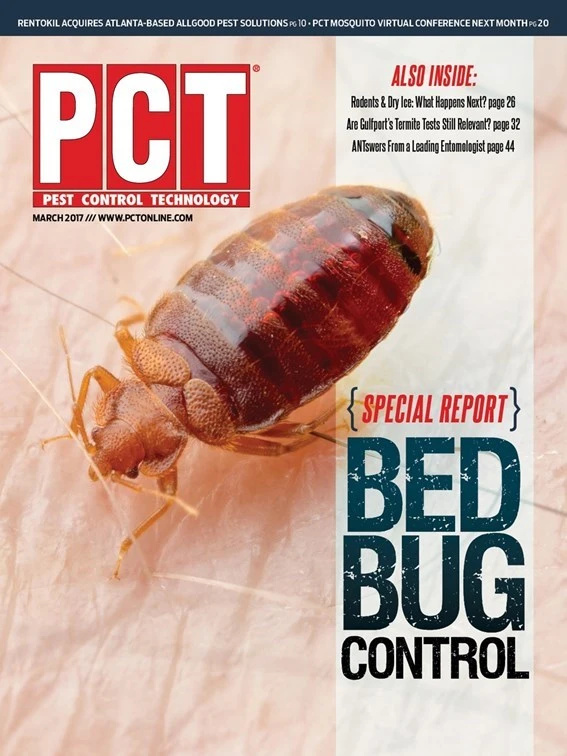
Even though swarms are not what they used to be, termites certainly are still around. Once a cornerstone of many PMPs’ business models, these pests are no longer making the phones ring. So since PMPs can’t change termite behavior, they change what they can: their own behavior.
Innovative marketing, promoting other (a.k.a. growing) services and diversifying into other areas related to termite control are all helping PMPs grow revenues. PCT interviewed business owners from around the country to dig deeper into how they’re improving (or replacing) termite revenue.
CHALLENGING MARKET. “I can’t think that termites are becoming extinct,” says Clay Metcalfe, owner of Pest Patrol in Greensboro, N.C. Termite work is about 10 percent of his business, and it’s down slightly this year.
For Metcalfe, termite work isn’t particularly profitable compared to general pest control because of competitors who charge significantly less for the service. “Healthy competition is good,” Metcalfe says, “but huge price variations are not.” Metcalfe is talking about the difference between $400 and $1,200 for the same house.
Bernie Cox of Fidelity Exterminating in Aberdeen, Md., says termite work is not especially profitable for his business either. “It might be expensive for the homeowner to get a termite treatment, but those pesticides cost a lot of money,” he says.
Because of the products on the market today, Cox thinks there’s less business because once you treat a house, the neighbors are not calling in for service. “It used to be that you’d treat a house and force the termites to the house next door, so you got that account, too,” he says.
Barry Bowers of Bowco Laboratories Pest Control, Woodbridge, N.J., sees the same trend. Termite is about 35 percent of Bowers’ business, down a few percent since last year. But bed bug services are now 20 percent of the firm’s revenue. “At one time, that was zero,” Bowers points out, discussing how services come and go.
For Cox, bed bug work is also steadily growing and provides more profit in an eight-hour day than termite work. “It’s not a lot of pesticide cost,” he says. “Bed bug work is time consuming, but I’m paying for labor anyway whether technicians are in the office, treating termites or taking care of bed bugs.”

Rather than investing in termite business, Cox purchased a $60,000 heater to treat bed bugs. “It has actually paid for itself several times over,” he says, adding that other pest control firms subcontract bed bug work to his business.
As for termite investment, Cox joins 44 percent of respondents to a recent PCT/Readex Research survey who said they’ll spend the same for termite this year. Forty-eight percent will increase their investment somewhat. And based on the survey, very few PCOs are giving up on the termite market completely, with just 3 percent noting they’d decrease their termite investment somewhat or significantly.
DIVERSIFICATION IS KEY. Marketing has made a difference for Ed Prine of Sonic Services in Stone Mountain, Ga., who reaches out to Realtors by distributing flyers in their office mailboxes. Some real estate companies allow Prine to visit during staff meetings to give a five-minute presentation. “They know that sellers need to have the termite work done and they want the process to be as easy as possible,” he says.
Joe Silvestrini, president, Pest Control Technicians, Norristown, Pa., added a termite monitoring program to his firm’s residential pest control program. “So, people can buy termite monitoring as an add-on service, and if they do get a termite problem they can get a discounted rate for treatments,” he explains.
Gordon Redd Jr., president of Redd Pest Solutions, Gulfport, Miss., says cross-selling services helps increase business. “There is a greater percentage of termite control customers than what it used to be, and we try to sell a current pest control customer termite control and that has been very good for our business,” he says.
Redd’s termite customers can pay an annual renewal fee (which is nice recurring revenue for the company). “That also continues our obligation to the customer as far as re-treatment requirements and replacement if they were to have termite damage,” Redd says. Baiting systems call for ongoing monitoring to ensure that 24/7 coverage. “There really is no need to re-treat, and we try to tell them that.”
Essentially, baiting technology is also helping Redd sell more clients on the assurance of around-the-clock termite protection. “With liquids, retreatment might need to be done every five or six years here, but with the baits, it’s 24/7 as long as customers pay the renewal fee and we continue monitoring and replacing baits as necessary,” he says.
For Advanced Services in Augusta, Ga., owner Jeff Annis, the way termite work is being sold as protection has struck a chord with customers. He points out that homeowners like their insurance. And unlike actual homeowners’ insurance where an agent sells it, signs it and finishes the deal, pest control “insurance” involves an ongoing relationship that people like because they see a service professional on the property regularly making sure that their home is protected. “It’s interesting to see how homeowners really value that annual thorough inspection and how that has remained a real backbone of how they feel about the service we provide,” Annis says.
The author is a frequent contributor to PCT.
Explore the March 2017 Issue
Check out more from this issue and find your next story to read.
Latest from Pest Control Technology
- Donny Oswalt Shares What Makes Termites a 'Tricky' Pest
- Study Finds Fecal Tests Can Reveal Active Termite Infestations
- Peachtree Pest Control Partners with Local Nonprofits to Fight Food Insecurity
- Allergy Technologies, PHA Expand ATAHC Complete Program to Protect 8,500 Homes
- Housecall Pro Hosts '25 Winter Summit Featuring Mike Rowe
- Advanced Education
- Spotted Lanternflies, BMSBs Most Problematic Invasive Pests, Poll Finds
- Ecolab Acquires Guardian Pest Solutions





